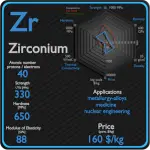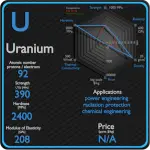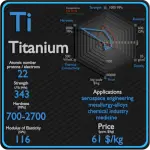This article contains comparison of key thermal and atomic properties of titanium and uranium, two comparable chemical elements from the periodic table. It also contains basic descriptions and applications of both elements. Titanium vs Uranium.

Titanium and Uranium – About Elements


Source: www.luciteria.com
Titanium and Uranium – Applications
Titanium
The two most useful properties of the metal are corrosion resistance and strength-to-density ratio, the highest of any metallic element. The corrosion resistance of titanium alloys at normal temperatures is unusually high. These properties determine application of titanium and its alloys. The earliest production application of titanium was in 1952, for the nacelles and firewalls of the Douglas DC-7 airliner. High specific strength, good fatigue resistance and creep life, and good fracture toughness are characteristics that make titanium a preferred metal for aerospace applications. Aerospace applications, including use in both structural (airframe) components and jet engines, still account for the largest share of titanium alloy use. On the supersonic aircraft SR-71, titanium was used for 85% of the structure. Due to very high inertness, titanium has many biomedical applications, which is based on its inertness in the human body, that is, resistance to corrosion by body fluids.
Uranium
The main use of uranium in the civilian sector is to fuel nuclear power plants. One kilogram of uranium-235 can theoretically produce about 20 terajoules of energy, assuming complete fission; as much energy as 1.5 million kilograms (1,500 tonnes) of coal. Typical reactor may contain about 100 tonnes of enriched uranium (i.e. about 113 tonnes of uranium dioxide). This fuel is loaded within, for example, 157 fuel assemblies composed of over 45,000 fuel rods. A common fuel assembly contain energy for approximately 4 years of operation at full power. The removed fuel (spent nuclear fuel) still contains about 96% of reusable material (it must be removed due to decreasing kinf of an assembly). Before (and, occasionally, after) the discovery of radioactivity, uranium was primarily used in small amounts for yellow glass and pottery glazes, such as uranium glass. Uranium is also used by the military to power nuclear submarines and in nuclear weapons. Due to its high density, this material is found in inertial guidance systems and in gyroscopic compasses.[10] Depleted uranium is preferred over similarly dense metals due to its ability to be easily machined and cast as well as its relatively low cost. The main risk of exposure to depleted uranium is chemical poisoning by uranium oxide rather than radioactivity (uranium being only a weak alpha emitter). Depleted uranium is uranium that has much less uranium-235 than natural uranium. It is considerably less radioactive than natural uranium. It is a dense metal that can be used as ballast for ships and counterweights for aircraft. It is also used in ammunition and armour. Depleted uranium can be also used to shield radiation. Depleted uranium is much more effective due to its higher Z. Depleted uranium is used for shielding in portable gamma ray sources. Uranium is used in high-speed steels as an alloying agent to improve strength and toughness. Uranium trioxide (also called uranic oxide) with formula UO3, is an orange-yellow powder and is used as a pigment for ceramics. In glasses it produces a beautiful greenish-yellow “uranium glass”.
Titanium and Uranium – Comparison in Table
| Element | Titanium | Uranium |
| Density | 4.507 g/cm3 | 19.05 g/cm3 |
| Ultimate Tensile Strength | 434 MPa, 293 MPa (pure) | 390 MPa |
| Yield Strength | 380 MPa | 190 MPa |
| Young’s Modulus of Elasticity | 116 GPa | 208 GPa |
| Mohs Scale | 6 | 6 |
| Brinell Hardness | 700 – 2700 MPa | 2400 MPa |
| Vickers Hardness | 800 – 3400 MPa | 1960 MPa |
| Melting Point | 1668 °C | 1132 °C |
| Boiling Point | 3287 °C | 4131 °C |
| Thermal Conductivity | 21.9 W/mK | 27 W/mK |
| Thermal Expansion Coefficient | 8.6 µm/mK | 13.9 µm/mK |
| Specific Heat | 0.52 J/g K | 0.12 J/g K |
| Heat of Fusion | 15.45 kJ/mol | 8.52 kJ/mol |
| Heat of Vaporization | 421 kJ/mol | 417 kJ/mol |











